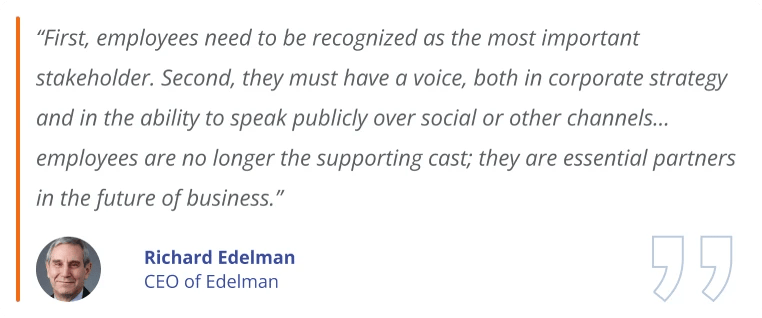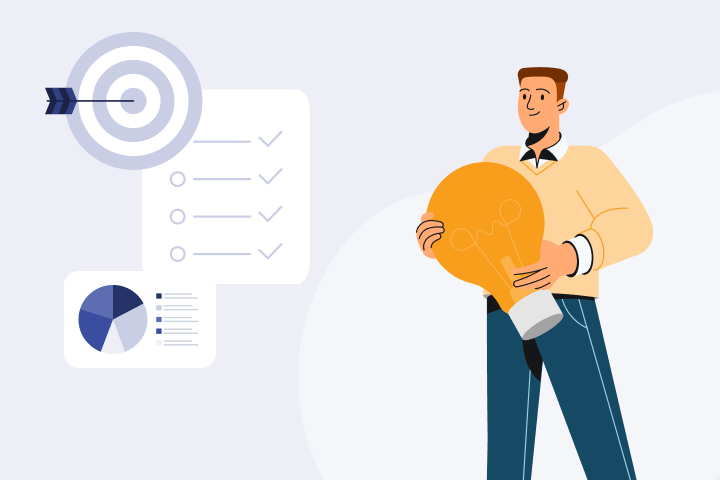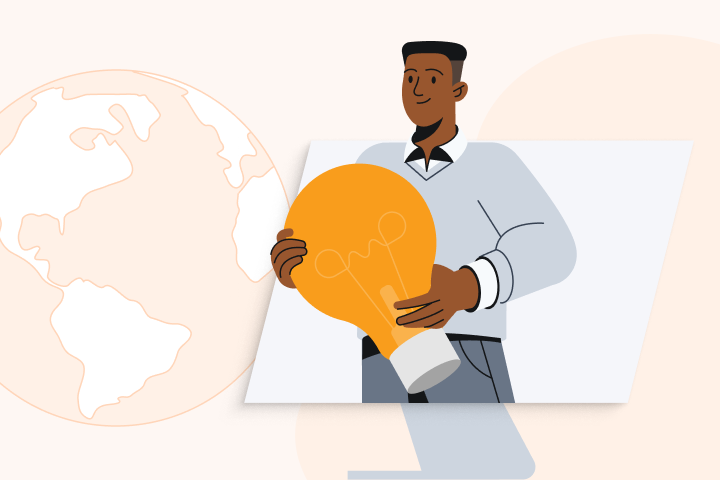LinkedIn Employee Advocacy Tool: How It Works and Why It Matters
You’ve probably used LinkedIn in the past to hire talent or grow your professional network. But have you ever used the LinkedIn employee advocacy tool?
Besides streamlining recruitment, LinkedIn can help you increase brand awareness, boost sales, and grow your organization. You can achieve all this and more by including LinkedIn in your employee advocacy strategy.
LinkedIn has over 900 million members in over 200 countries and regions. So, chances are many, if not all, of your employees, are already part of the platform. But how can you turn these employees into effective advocates for your business? Beyond creating LinkedIn guidelines for employees, you need a cohesive employee advocacy program to make the most of the LinkedIn employee advocacy tool.
Employee advocates are an integral but often ignored part of a company’s social media strategy. Employees can create and share valuable brand-related messaging from their LinkedIn accounts and other social media platforms. Employee advocates can share details about the brand’s products and services, insights into the company’s work culture, and announcements of awards or recognition that the organization has gained.
In this article, we’ll explain what is employee advocacy and the advantages of starting an employee advocacy program on LinkedIn. We’ll also highlight how you can make the most of your employees’ presence on the platform to set your business up for success.
What is Employee Advocacy?
Employee advocacy is a marketing strategy that leverages your employees' networks to increase brand awareness and your branded contents organic reach. It's a highly effective piece of the overall marketing strategy as it can significantly increase the reach of a piece of content without spending a dime on advertising efforts.
The Benefits of LinkedIn for Employee Advocacy
Your employees are your greatest resource and the most authentic representatives of your brand. Leveraging their voice and community on LinkedIn can bring many benefits, such as:
1. Upgrading Your Marketing Efforts
Most users proactively avoid paid promotions by using ad blockers, skipping ads, or spending extra for ad-free experiences; over 820 million global devices were blocking ads as of December 2021.
Marketers need to look beyond ads to boost the reach of brand-related content. The LinkedIn employee advocacy tool can exponentially increase organic traffic and engagement. While only 3% of employees share content about their company, those shares drive a 30% increase in the company's total engagement.
Driving engagement via employees requires a social media policy that sets guidelines to follow when publishing content online. Help your workforce understand LinkedIn’s best practices for employees so they can better assist you in achieving your goals from the advocacy program.
2. Boosting Sales and Increasing Revenue
LinkedIn is used by millions of professionals and businesses, making it an invaluable resource for B2B marketing. Today, 40% of B2B buyers use social media to help inform their purchasing decisions. Add to this the fact that LinkedIn has been rated the top platform for B2B lead generation, and audiences exposed to brand and acquisition messages on the platform are six times more likely to convert.

Creating connections is the first step for a successful salesperson, and LinkedIn makes it easy for your employees to grow their network and reach out to potential buyers. As your employees continue to post content regularly and establish themselves as thought leaders in the field, they’ll attract high-quality followers. As a result, more companies are embracing social selling - leveraging the social networks of salespeople to find the right leads, build relationships, and achieve sales goals.
You can also use LinkedIn Sales Navigator to help you target the right buyers, understand critical insights, and use personalized outreach at scale.
3. Gaining the Consumer’s Trust
Earning the trust of consumers is vital to gaining their business.
According to a report by Edelman, 88% of people believe that trust in a brand is a more critical factor than loving the products when it comes to making a purchase decision. The report also found that consumers reward trusted brands with advocacy (61%), purchase (57%), loyalty (43%), and engagement (31%).
In fact, the same report found that 40% of people don’t buy from brands that they love because they don’t trust the company that owns those brands.
4. Making Hiring More Efficient
When your employees enjoy their work and share their workplace experiences with others, it can influence potential candidates to apply to the company. This low-cost but effective way to attract the right talent to your company is especially valuable in a tough labor market.
Looking for some employee advocacy examples to decide if they’re effective? Consider this: If you’re applying for a role and trying to gauge whether an organization offers a healthy work-life balance, would you rather take the word of the CEO or an employee? Chances are you’ll probably consider the employee’s opinions more accurate and transparent.
Employee advocacy has a positive impact on your team as well. When employees are engaged in advocating for your business online, they become more invested in the company’s future and well-being. It makes them feel deeply connected to the organization and motivates them to ensure its success.
Engaged employees produce better business outcomes and are more productive. But only 36% of employees identify as engaged or highly involved, enthusiastic, and committed to their work. Employee advocacy programs can be an effective way to bring this number up.
In addition, employees’ increased passion for their workplace results in higher retention rates, allowing individuals to rise through the ranks while helping the employer save on recruitment costs.
To help businesses leverage the platform for their employee advocacy efforts, LinkedIn launched a unique product called Elevate (later integrated with Pages). Let’s take a look at what it initially offered users.
What Is LinkedIn Elevate?
In 2015, LinkedIn launched Elevate, a product created to support employee sharing on the platform. It was designed to help identify an organization’s most likely advocates, encourage them to engage with relevant content, and measure the impact of such conversations. It empowered employees to become social professionals and allowed companies to track the data, including job views and followers' changes, resulting from the shared content.
Elevate was launched as a paid tool, with pricing tiers based on the number of employees who needed access to the platform.
However, in 2020, Linkedin announced its decision to integrate Elevate with Pages. According to the platform, this decision was meant to help businesses better engage their employees and build stronger communities. Page admins can engage their entire teams rather than those covered by the paid Elevate product.

There are two significant changes that this merger has brought. First, with Elevate integrating into Pages, it has become a free product. However, this has caused it to lose some functionality, including specific controls, leaderboards, and LinkedIn employee advocacy analytics. Some analytics that remain include graphs for:
-
Employee Advocacy Metrics: Total number of recommendations, posts from recommendations, reactions to posts, comments on posts and reposts over a given time period.
-
Employees Posting from Recommendations: Job function, seniority, and location of employees posting from recommendations.
-
LinkedIn Members Reached: Job function, seniority, and location of employees posting from recommendations.
-
Recommendation Engagement: All recommendations published to employees.
However, while this free version will save companies money, it’s scaled-down compared to other employee advocacy platforms, and it will not meet all of their needs. Plus, it is only good for LinkedIn. So, if your buyer audience isn’t on LinkedIn, you will still need a different platform to reach them.
This doesn’t mean LinkedIn is no longer effective for employee advocacy. Instead, businesses must change how they use the platform and tweak their strategies for the best results.
How to Use LinkedIn for Employee Advocacy in 2023?
Now that Elevate no longer exists, what is employee advocacy on LinkedIn? LinkedIn Pages has several features to help engage employees and encourage them to advocate for your business. Among other things, it allows you to:
-
Re-share your employees' best mentions and content.
-
Notify employees of posts on LinkedIn by sending employees a notification when you post something on your Page. This boosts organic reach and engagement.
-
Highlight milestone team moments or feature high-performing employees with a shout-out on your Page.
-
Build internal engagement through an employee-only community on LinkedIn by using the "My Company" tab.
Unfortunately, employee advocacy analytics on LinkedIn are scant and if you're serious about your employee advocacy efforts, you'll want to consider a true employee advocacy platform for your efforts.
Elevate Your Employee Advocacy Efforts With GaggleAMP
For organizations that wish to enjoy the benefits of employee advocacy on LinkedIn, the enhanced LinkedIn Pages product is not enough. The challenge is in finding a suitable alternative that is reliable and multi-functional in the long run. Changing your tech stack is hard enough, so you don’t want to do it multiple times.
That’s where employee advocacy tools like GaggleAMP come in. Our cohesive employee advocacy program has many powerful features to help you extend your content’s reach, drive engagement, increase social selling, and boost internal communications. More than 100,000 people trust GaggleAMP for employee advocacy. Our easy-to-use platform makes it simple to strengthen your social media presence through the authenticity of your employees.

Your employees are your most credible brand advocates, and when they post about the organization, it’s far more effective than when it comes from the brand directly. Ready to harness this incredible power to boost your marketing, sales, and recruitment efforts?
Get your employees to share brand-related content on LinkedIn today by requesting a demo.












